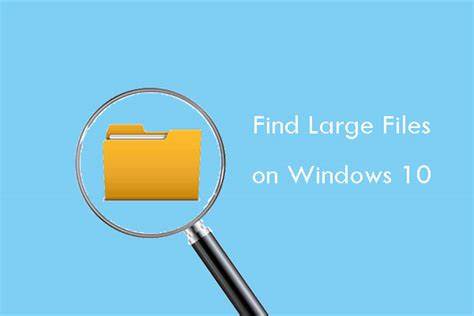How to Find Large Files Taking Up Space in Windows
Is your Windows drive running low on space? Over time, large files can accumulate, silently eating away at your valuable storage. Identifying these space hogs is the first crucial step to freeing up disk space and improving your computer’s performance. Knowing how to find large files taking up space in Windows is a fundamental skill for maintaining a healthy and efficient system. This guide will walk you through various methods, from built-in Windows tools to third-party solutions, ensuring you can quickly pinpoint and manage those oversized files.
Why Find Large Files Taking Up Space in Windows?
Locating and managing large files taking up space in Windows is essential for several reasons:
- Free Up Disk Space: The most obvious benefit. More free space means your computer can run more smoothly.
- Improve Performance: Low disk space can lead to a sluggish system, slow application loading, and even system crashes.
- Prevent Errors: Critical Windows updates often require significant free space.
- Better Organization: Helps you understand what’s stored on your drive and keep it tidy.
- Backup Efficiency: Knowing where large files are helps prioritize what to back up.
- Identify Unnecessary Data: You might discover forgotten downloads, old video projects, or duplicated files you no longer need.
Common Culprits for Large Files:
- Video Files: Movies, TV shows, screen recordings, unedited video projects.
- Game Installations: Modern games can take up hundreds of gigabytes.
- ISO Files: Disk images for operating systems or large software.
- Backup Files: Old system backups, phone backups.
- Unused Software Installers: Downloaded .exe or .msi files that were never deleted.
- Temporary Files and Cache: While usually smaller, large accumulated caches can be an issue.
- Duplicate Files: Multiple copies of the same large file.
Step-by-Step Guide: How to Find Large Files Taking Up Space in Windows
Windows offers several built-in tools, and there are excellent third-party utilities that make this task much easier.
Method 1: Using Windows Storage Sense (Windows 10 & 11)
Storage Sense is a powerful built-in tool that provides an overview of your disk usage and helps manage temporary and large files.
- Open Settings:
- Click the Start button.
- Select Settings (the cogwheel icon).
- Alternatively, press Windows key + I.
- Navigate to Storage Settings:
- In the Settings window, click on “System” in the left-hand menu.
- Then, click on “Storage”.
- Analyze Drive Usage:
- You’ll see a breakdown of your drive usage (e.g., “Apps & features,” “Temporary files,” “Documents,” “Other”).
- Click on “Show more categories” (Windows 11) or scroll down to see a more detailed breakdown (Windows 10).
- Identify Large File Categories:
- Look for categories that are consuming significant space.
- “Temporary files”: This is a great place to start cleaning. Click on it to see options for deleting old downloads, Recycle Bin contents, and temporary app files.
- “Other” / “Documents” / “Pictures” / “Videos”: These categories often contain user-generated large files. Clicking on them might not directly show you individual files, but it gives you an idea of where to look next.
- “Apps & features”: Shows installed programs. You can uninstall large, unused programs from here.
- Utilize “Cleanup recommendations” (Windows 11):
- On Windows 11, under “Storage usage,” you’ll find “Cleanup recommendations.” Click this.
- This section intelligently suggests files you can safely delete, including large unused files, synced cloud files, and temporary files. It’s often the easiest way to start freeing up space.
- Run Storage Sense (Optional Automation):
- On the main Storage screen, you can also toggle “Storage Sense” to “On.”
- Click “Configure Storage Sense or run it now” to customize when it automatically cleans up temporary files and Recycle Bin content.
Method 2: Using File Explorer Search (Windows 10 & 11)
File Explorer’s search capabilities allow you to filter files by size.
- Open File Explorer:
- Click the File Explorer icon (folder icon) on your taskbar.
- Alternatively, press Windows key + E.
- Select the Drive to Search:
- In the left pane, click on “This PC” or the specific drive you want to analyze (e.g., Local Disk (C:)).
- Start a Search:
- In the search bar at the top right of the File Explorer window, type “size:” followed by a size category.
- Common Size Categories:
- size:gigantic (Greater than 128 MB)
- size:huge (128 MB to 1 GB)
- size:large (1 MB to 128 MB)
- Custom Size (More Precise): For more control, you can use greater than/less than operators:
- size:>1GB (finds files larger than 1 Gigabyte)
- size:>=500MB (finds files larger than or equal to 500 Megabytes)
- size:<100MB (finds files smaller than 100 Megabytes)
- Sort by Size:
- After the search results populate, click on the “Size” column header to sort the files from largest to smallest. This will immediately show you the biggest files.
- Refine Search (Optional):
- You can combine size searches with file types (e.g., *.mp4 size:>1GB to find large video files) or dates (e.g., date:last year size:>500MB).
- Manage Files:
- Once you’ve identified large files, you can right-click on them to delete, move to an external drive, or upload to cloud storage.
Method 3: Using Disk Cleanup (Older but Still Useful)
While Storage Sense is the modern approach, Disk Cleanup is a classic Windows tool for removing temporary and system files.
- Open Disk Cleanup:
- Click the Start button.
- Type “Disk Cleanup” and press Enter.
- Select Drive:
- Choose the drive you want to clean (usually C:). Click “OK.”
- Scan and Select Files:
- Disk Cleanup will scan your drive.
- In the list of “Files to delete,” check the boxes next to categories you want to clean (e.g., “Temporary Internet Files,” “Recycle Bin,” “Temporary files”).
- Clean Up System Files (Crucial for large files):
- For more significant space savings, click “Clean up system files.” This will restart the scan but include options like “Windows Update Cleanup,” “Previous Windows installation(s),” and “Windows upgrade log files,” which can be very large.
- After the second scan, select the additional categories you wish to delete.
- Confirm Deletion:
- Click “OK” and then “Delete Files” to confirm.
Method 4: Using Third-Party Disk Space Analyzer Tools (Highly Recommended for Visual Overview)
For a comprehensive, visual understanding of disk usage, third-party tools are often superior.
- Recommended Tools:
- WinDirStat: Free, open-source, and provides a unique graphical “treemap” view of your disk, where larger blocks represent larger files/folders. Extremely intuitive for identifying space hogs.
- TreeSize Free: Another excellent free utility that quickly scans drives and presents a detailed, sortable list of folders and files by size.
- SpaceSniffer: Similar to WinDirStat, offering a clear visual representation.
- How to Use (General Steps for Most Tools):
- Download and Install: Download the chosen tool from its official website.
- Run as Administrator: Launch the tool (often needs administrator privileges to scan all areas).
- Select Drive: Choose the drive you want to scan.
- Analyze Results: The tool will scan and then display a graphical or hierarchical view of your disk space.
- Drill Down: Click on large folders or blocks to “drill down” and see what files are inside. This quickly guides you to the biggest culprits.
- Manage Files: Most tools allow you to right-click on identified files/folders to delete them, open their location, or move them.
My Personal Experience with Finding Large Files
I’ve been in the situation countless times where my C: drive was inexplicably full, slowing everything down. Initially, I just deleted temporary files and ran Disk Cleanup, but it never freed up enough space. That’s when I discovered WinDirStat. The first time I ran it, seeing that colorful treemap instantly showed me that gigabytes of space were being eaten up by old game installation files I’d forgotten about, and huge video clips from a project I’d finished months ago, buried deep in obscure folders. The visual representation made it incredibly easy to pinpoint the culprits, even those hidden away, allowing me to recover massive amounts of space. It transformed how I approached disk management and became my go-to tool for deep dives into storage usage.
Conclusion
Knowing how to find large files taking up space in Windows is a fundamental skill for maintaining a healthy and responsive computer. Whether you prefer the built-in Windows Storage Sense and File Explorer search, the classic Disk Cleanup, or the powerful visual insights of third-party disk analyzers, you have multiple effective methods at your disposal. By regularly identifying and managing these oversized files, you can ensure your Windows system remains performant and free from storage-related slowdowns.





